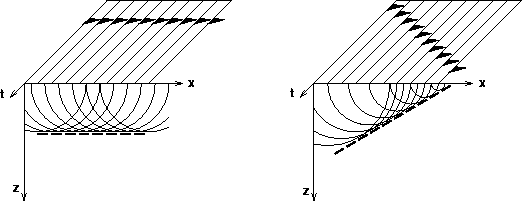




Next: Surface-oriented wavefront synthesis
Up: Imaging by wavefront synthesis
Previous: The forward model
A wave stack is any stack over a common shot
or geophone gather in which the moveout is independent of time
Schultz and Claerbout (1978).
It synthesizes a particular wavefront of raw data
because Huygens' principle permits the synthesis
of arbitrarily-shaped downward propagating wavefronts
from the superposition of many spherical wavefronts.
In other words, a line-source can be simulated by firing
many smaller, closely-spaced point sources
simultaneously or sequentially (Figure ![[*]](http://sepwww.stanford.edu/latex2html/cross_ref_motif.gif) ).
Unlike the common midpoint stack,
wave stacks have the important property
of being the sampling of a wavefield and,
as such, permit the treatment of
formerly difficult or impossible problems
with the use of the wave equationSchultz and Claerbout (1978).
).
Unlike the common midpoint stack,
wave stacks have the important property
of being the sampling of a wavefield and,
as such, permit the treatment of
formerly difficult or impossible problems
with the use of the wave equationSchultz and Claerbout (1978).
Huygens
Figure 3 A line source can be simulated by firing many point sources
simultaneously or sequentially so as to result in a plane wavefront.

One of the most attractive features of the wave stack
method is computational efficiency.
Stacking along common geophone gathers
significantly reduces the size of the data space
to be migrated and produces a stacked section
which has the same size as a common-offset section.
Compared to shot profile migration,
which requires the migration of all shot profiles
to obtain a global picture of the subsurface image,
the use of a wave stack reduces the size of the data space
to be migrated by the order of the number of shots
as common-offset migration dose.
Another advantage of the wave stack is
that it provides a way to get an interpretable image
in terms of angle-dependent reflection coefficients by controlling the
incidence angle of the wavefront synthesized to a reflector.
The wave stack can be formulated by means of the linear property
of the forward model operator, equation (![[*]](http://sepwww.stanford.edu/latex2html/cross_ref_motif.gif) ).
Since the forward operator in equation (
).
Since the forward operator in equation (![[*]](http://sepwww.stanford.edu/latex2html/cross_ref_motif.gif) )
is independent of time, a linear combination of the
recorded trace can be expressed by the combination of source
functions as follows :
)
is independent of time, a linear combination of the
recorded trace can be expressed by the combination of source
functions as follows :
|  |
(3) |
where M is the number of source functions used for wave stacking
and  is any complex value.
The
is any complex value.
The  is called a synthesis operator because it synthesizes
a wavefront by scaling the amplitude and shifting the phase
of each source function.
Therefore, we can control the wavefront
by adjusting
is called a synthesis operator because it synthesizes
a wavefront by scaling the amplitude and shifting the phase
of each source function.
Therefore, we can control the wavefront
by adjusting  appropriately.
Equation (
appropriately.
Equation (![[*]](http://sepwww.stanford.edu/latex2html/cross_ref_motif.gif) ) can be simplified as
) can be simplified as
|  |
(4) |
where  is called synthesized stack
and
is called synthesized stack
and  is the synthesis operator
because it is equal to
is the synthesis operator
because it is equal to  if we assume
each shot is an impulse.
The following sections explain how to determine
if we assume
each shot is an impulse.
The following sections explain how to determine  according to the shape of the wavefront at the surface and subsurface.
according to the shape of the wavefront at the surface and subsurface.





Next: Surface-oriented wavefront synthesis
Up: Imaging by wavefront synthesis
Previous: The forward model
Stanford Exploration Project
2/5/2001
![[*]](http://sepwww.stanford.edu/latex2html/cross_ref_motif.gif) ).
Unlike the common midpoint stack,
wave stacks have the important property
of being the sampling of a wavefield and,
as such, permit the treatment of
formerly difficult or impossible problems
with the use of the wave equationSchultz and Claerbout (1978).
).
Unlike the common midpoint stack,
wave stacks have the important property
of being the sampling of a wavefield and,
as such, permit the treatment of
formerly difficult or impossible problems
with the use of the wave equationSchultz and Claerbout (1978).

